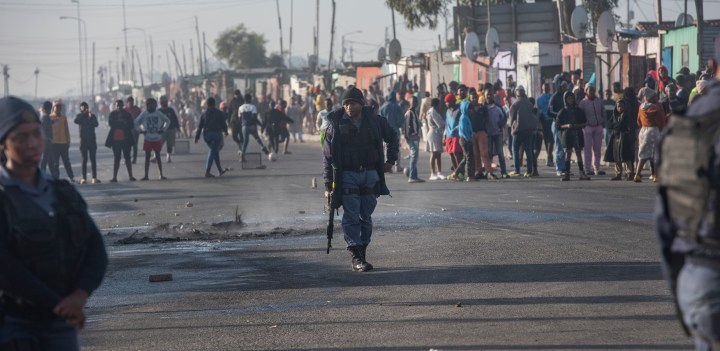LIVING ON THE EDGE OP-ED
The anomaly in crime stats that results in high murder areas getting fewer police officers

A process has finally commenced within SAPS, which, it is hoped, will see places like Nyanga get at least an average share of policing — rather than a lower share.
Maurice Smither’s experience as related by him in Daily Maverick is but one example of what happens in slow traffic in high murder-rate areas of Cape Town. Many outsiders go into these areas knowing the risk; residents have little choice.
But recently, NGOs and even government services are withdrawing from places like Nyanga and Philippi, because it is simply too dangerous. Part of the problem is that police resources are irrationally lower in these areas. The good news is that change at last seems possible after a decade of advocacy and litigation.
Philippi has a murder rate of 272 per 100,000. That means one in every 370 people living there is killed violently every year. For comparison, the number of deaths in Ukraine due to war so far is about 160 per 100,000; the South African murder rate is about 45 per 100,000 at present.
But Philippi doesn’t have a high (reported) crime rate. Yes, read that again. Leafy Claremont has more of SAPS’ 17 “community-reported crimes” than does Philippi: around 3,000 per year (of which, zero to two murders), compared to Philippi’s 2,000 (of which 60 to 90 murders). Claremont’s population is about a third smaller.
It is noticeable that in Smithers’ narrative, he did not mention going to the police station to report the crime. Many people don’t report crime, for various rational reasons. Yet, SAPS has tended to take their own crime data at face value. Indeed, reported crime is central to the SAPS formula which underpins the allocation of police officer resources to police stations.
Thus Claremont is allocated more police officers per population than Philippi or Nyanga, or many similar places. This anomaly was uncovered in the Khayelitsha Commission of Inquiry, which commenced in 2012. Then, it was found that Harare, a police station in Khayelitsha, had the lowest per-population allocation of all 152 police stations in the Western Cape, despite a high murder rate. All township areas had lower than median allocations.
Furthermore, survey evidence showed vastly varying rates of reporting of crime among police stations in the province, with high murder areas having the lowest crime reporting rates. This skewness in reporting may be worse in the Western Cape than elsewhere, resulting in relatively more skewed resource allocations in the province.
The commission, in its report of 2014, made a number of recommendations, including that SAPS should review its formula toward improving its relative allocations to high murder rate areas.
Years of stagnation
A few years passed and little changed. The Social Justice Coalition took SAPS to the Equality Court in 2016. Another few years passed, but eventually, the court found against SAPS in 2019. The court did not immediately decide on a remedy, but eventually ordered the parties to meet, toward agreeing on changes that might remedy the anomaly.
This meeting took place three weeks ago. The SAPS, for the first time, appeared to accept that it did not make sense that high murder rate areas have low policing rates, and that perhaps reported crime was not the full picture. This may be because the anomalously low reported crime during the lockdown is pushing down the calculated police officer resource numbers everywhere, causing other problems.
A process has finally commenced within SAPS, which, it is hoped, will see places like Nyanga get at least an average share of policing — rather than a lower share.
Unfortunately, budget cuts mean that the total number of police officers available to distribute has gone down significantly. Also, there are problems with the internal tasking within police stations, particularly large ones (most township police stations are large, serving large areas), as well as strategies adopted in relation to crime prevention, and the plethora of administrative tasks imposed on SAPS in terms of legislation.
But it is a start, and marks an important shift within the SAPS. There may be the barest glimmer of light at the end of the township policing tunnel. DM
Dr Jean Redpath is a Senior Researcher at the Dullah Omar Institute, University of the Western Cape. She gave evidence at the Khayelitsha Commission and in the matter of Social Justice Coalition and Others v Minister of Police and Others.




















 Become an Insider
Become an Insider
And that foolish man Bheki Cele has presided over this chaos. Perhaps one if the “rational reasons” people don’t report crime is because of the way they are treated in police stations: disrespectfully. It gets report simply for insurance purposes. How many of these reported crimes are solved, I wonder. My guess – not many. 10%?
Jean Redpath is correct that many people don’t bother to report crimes, partly because they don’t expect the police to do anything useful. She is also correct in saying I didn’t mention going to the police in my article, but I did in fact do so. I first tried to report it at the Muizenberg Police Station but left in frustration because of the shoddy service that I received. The officer I spoke to seemed to be more interested in putting obstacles in the way of my opening a case than in helping me.
I then tried again at the police station at Cape Town International Airport. There I was able to open a case, but not without difficulty. Once again, I found the SAPS very unhelpful. The officer helping me insisted that I needed to say exactly where the incident took place and didn’t seem to understand that it was difficult to so so because, after the incident, my only concern – and the concern of sympathetic bystanders – was that I should get out of there. Fortunately I was able to work out where it was by using street view in Google Maps, but overall I can say that dealing with the SAPS was not a supportive experience. As one of the commentators below points out, many people only report a crime for insurance purposes and I have to say that that was the only reason I persisted.